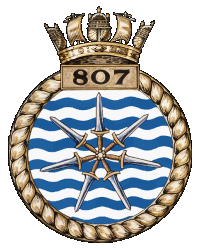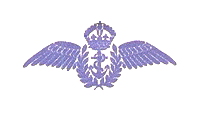

'Quoquo versus ferituri' - Ready to strike in all directions
'No.807 Royal Navy Squadron'
(15th September 1940 to 14th September 1948)
No.807 Squadron was formed at Worthy Down on 15th September 1940 as fighter squadron with nine Fulmar I's, increasing later to twelve aircraft. Three of these embarked on HMS. Pegasus in December 1940 for fighter catapult operations. After disembarking in February 1941, the whole squadron joined HMS. Furious later for convoy escort duty. Re-equipping with twelve Fulmar II's in April 1941, No.807 joined HMS. Ark Royal and shared the destruction of fifteen enemy aircraft with No.806 Squadron during Malta convoy duties in July and September 1941, another being probably destroyed and a further four damaged. When the ship was torpedoed on 13th November 1941 the four surviving aircraft flew to North Front in Gibraltar.
Fresh Fulmars were then issued to the squadron, in addition to which two sea Hurricanes were used briefly and with these the squadron embarked on HMS. Argus for further convoy duties. During June 1942, four aircraft were each embarked on HMS. Argus and HMS. Eagle for the defence of Operation Harpoon, a relief convoy to Malta, four Italian aircraft were shot down, but five squadron Fulmars were also unfortunately lost. The squadron then returned to the United Kingdom to become the first to receive Seafires, a few Ib's being used for training whilst re-equipping with twelve IIc's. With these the squadron joined HMS. Furious in August 1942 and in November 1942 took part in the North African landings, shooting down two French aircraft, damaging two others and damaging two others on the ground.
Returning home in March 1943, the squadron undertook Army support training and received new L.IIc's on 15th May 1943, with which it embarked on HMS. Indomitable two weeks later. During the Sicily landings the ship provided cover for the invasion fleets and possible interference from the Italian Fleet, but was damaged by an enemy torpedo on 16th July 1943. Transferring to HMS. Battler, No.807 then provided similar cover for the Salerno landings, aircraft of one flight operating from a beach-head airstrip for a time.
After returning home on HMS. Hunter, No.807 trained in amphibious support and combined operations, tactical reconnaissance training being undertaken at Burscough and then Andover. Now part of the 4th Naval Fighter Wing, the strength was increased to twenty aircraft when it took over part of No.808 Squadron in February 1944. Returning to the Mediterranean in April 1944, detachments were lent to the Desert Air Force in Italy for several weeks, some Seafire L.III's being received in June 1944. The squadron was then reunited on board HMS. Hunter to participate in the South of France landings in August 1944. No.807 inflicted considerable damage to locomotives and motor transport during this operation which was code-named 'Operation Dragoon'. During September and October 1944 the squadron took part in army support operations in the Aegean, then disembarked to Dekheila to regroup whilst the ship was refitted.
Re-embarking in March 1945, HMS. Hunter sailed to join the Eastern Fleet and No.807 provided fighter support during April and May 1945 for the re-occupation of Rangoon, following which cover was given for anti-shipping strikes in the Andaman Sea. VJ-day forestalled the planned operations during the re-occupation of Penang and the ship sailed for home. On return the squadron re-equipped with twelve Seafire XVII's and spent most of 1946 working up. In May 1947 the squadron embarked on HMS. Vengeance for a Norwegian Cruise and departed afterwards to Gosport on 4th August 1947. Re-equipping in September 1947 with twelve Sea Fury F.10's., the squadron joined the 17th Carrier Air Group and after exchanging them for FB.II's, embarked on HMS. Theseus on 14th September 1948 for a cruise to South Africa.
